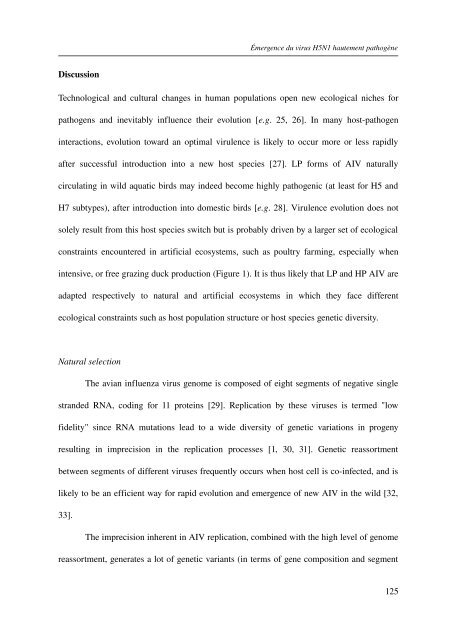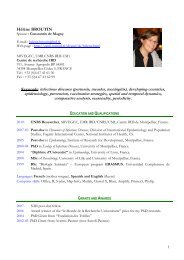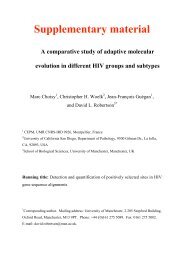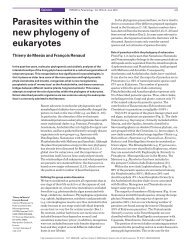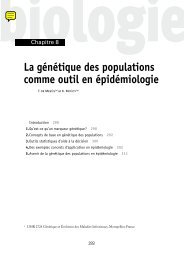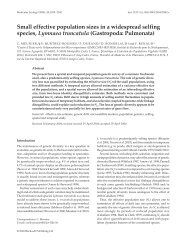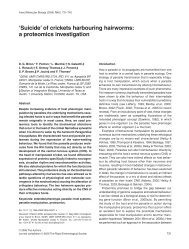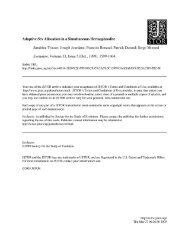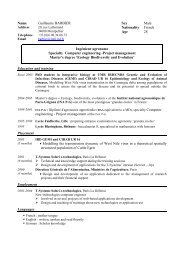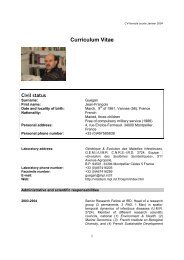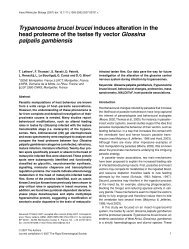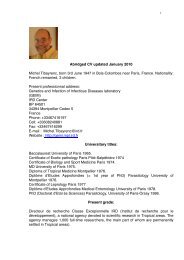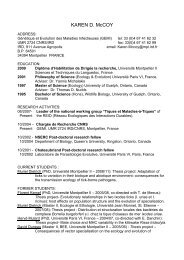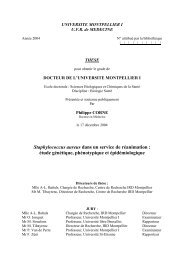écologie des virus influenza aviaires en Camargue - IRD
écologie des virus influenza aviaires en Camargue - IRD
écologie des virus influenza aviaires en Camargue - IRD
You also want an ePaper? Increase the reach of your titles
YUMPU automatically turns print PDFs into web optimized ePapers that Google loves.
Émerg<strong>en</strong>ce du <strong>virus</strong> H5N1 hautem<strong>en</strong>t pathogèneDiscussionTechnological and cultural changes in human populations op<strong>en</strong> new ecological niches forpathog<strong>en</strong>s and inevitably influ<strong>en</strong>ce their evolution [e.g. 25, 26]. In many hostpathog<strong>en</strong>interactions, evolution toward an optimal virul<strong>en</strong>ce is likely to occur more or less rapidlyafter successful introduction into a new host species [27]. LP forms of AIV naturallycirculating in wild aquatic birds may indeed become highly pathog<strong>en</strong>ic (at least for H5 andH7 subtypes), after introduction into domestic birds [e.g. 28]. Virul<strong>en</strong>ce evolution does notsolely result from this host species switch but is probably driv<strong>en</strong> by a larger set of ecologicalconstraints <strong>en</strong>countered in artificial ecosystems, such as poultry farming, especially wh<strong>en</strong>int<strong>en</strong>sive, or free grazing duck production (Figure 1). It is thus likely that LP and HP AIV areadapted respectively to natural and artificial ecosystems in which they face differ<strong>en</strong>tecological constraints such as host population structure or host species g<strong>en</strong>etic diversity.Natural selectionThe avian <strong>influ<strong>en</strong>za</strong> <strong>virus</strong> g<strong>en</strong>ome is composed of eight segm<strong>en</strong>ts of negative singlestranded RNA, coding for 11 proteins [29]. Replication by these <strong>virus</strong>es is termed "lowfidelity" since RNA mutations lead to a wide diversity of g<strong>en</strong>etic variations in prog<strong>en</strong>yresulting in imprecision in the replication processes [1, 30, 31]. G<strong>en</strong>etic reassortm<strong>en</strong>tbetwe<strong>en</strong> segm<strong>en</strong>ts of differ<strong>en</strong>t <strong>virus</strong>es frequ<strong>en</strong>tly occurs wh<strong>en</strong> host cell is coinfected, and islikely to be an effici<strong>en</strong>t way for rapid evolution and emerg<strong>en</strong>ce of new AIV in the wild [32,33].The imprecision inher<strong>en</strong>t in AIV replication, combined with the high level of g<strong>en</strong>omereassortm<strong>en</strong>t, g<strong>en</strong>erates a lot of g<strong>en</strong>etic variants (in terms of g<strong>en</strong>e composition and segm<strong>en</strong>t125


